

Mathematical Logic and Proofs - Mathematics LibreTexts. Mathematics is really about proving general statements via arguments, usually called proofs.

We start with some given conditions, the premises of our argument, and from these we find a consequence of interest, our conclusion. The problem is, as you no doubt know from arguing with friends, not all arguments are good arguments. A “bad” argument is one in which the conclusion does not follow from the premises, i.e., the conclusion is not a consequence of the premises. Logic is the study of what makes an argument good or bad. Mathematical logic is the subfield of philosophical logic devoted to logical systems that have been sufficiently formalized for mathematical study.
Induction. Trigonometry. Youtube. Sets and functions. Transition to Higher Mathematics: Structure and Proof - Second Edition. Free Introduction to Mathematical Proofs textbook. Introduction to Proofs: an Inquiry-based Approach by Jim Hefferon is for a Mathematics major course that is inquiry-based, sometimes known as “Moore method.”
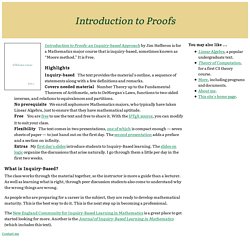
It is Free. Highlights Inquiry-based The text provides the material's outline, a sequence of statements along with a few definitions and remarks. Covers needed material Number Theory up to the Fundamental Theorem of Arithmetic, sets to DeMorgan's Laws, functions to two-sided inverses, and relations to equivalences and partitions. No prerequisite We enroll sophomore Mathematics majors, who typically have taken Linear Algebra, just to ensure that they have mathematical aptitude. What is Inquiry-Based? The class works through the material together, so the instructor is more a guide than a lecturer. As people who are preparing for a career in the subject, they are ready to develop mathematical maturity. The New England Community for Inquiry-Based Learning in Mathematics is a great place to get started looking for more.
Introduction to Foundations of Pure Mathematics - Dr Joel Feinstein. Youtube.
Math Foundations C (150. Math Foundations B (80-149) Math Foundations A (1-79) Probability and Statistics: an introduction. GCSE Maths - BBC Bitesize. Free Math Apps - used by over 100 Million Students & Teachers Worldwide. Introduction to Higher Mathematics. By Department of Mathematics Whitman College This work is licensed under the Creative Commons Attribution-NonCommercial-ShareAlike License.
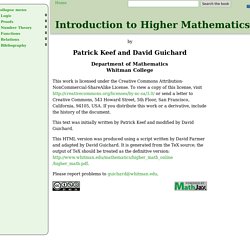
To view a copy of this license, visit or send a letter to Creative Commons, 543 Howard Street, 5th Floor, San Francisco, California, 94105, USA. If you distribute this work or a derivative, include the history of the document. This text was initially written by Patrick Keef and modified by David Guichard. This HTML version was produced using a script written by David Farmer and adapted by David Guichard. Please report problems to guichard@whitman.edu. Mathematics resources - www.mathcentre.ac.uk or. Multiplicative inverse.
The reciprocal function: y = 1/x.
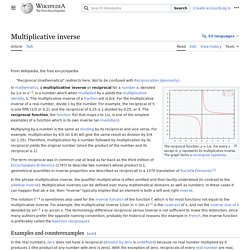
For every x except 0, y represents its multiplicative inverse. The graph forms a rectangular hyperbola. Multiplying a number is the same as dividing its reciprocal and vice versa. For example, multiplication by 4/5 (or 0.8) will give the same result as division by 5/4 (or 1.25). Therefore, multiplication by a number followed by multiplication of its reciprocal will yield the original number (since their product is 1). The term reciprocal was in common use at least as far back as the third edition of Encyclopædia Britannica (1797), to describe two numbers whose product is 1; geometrical quantities in inverse proportion are described as reciprocall, in a 1570 translation of Euclid's Elements.[4] In the phrase multiplicative inverse, the qualifier multiplicative is often omitted, and then tacitly understood (in contrast to the additive inverse).
Examples and counterexamples[edit] Complex numbers[edit] , and using the property that . Calculus[edit] , so if. IPaMV. Jason Aubrey. Concepts of Mathematics - Summer I 2012. Announcements Friday 5/25/12: The LaTeX tutorial will be Tuesday May 29 at 5-6:30ish pm in Wean 5207Sunday 5/20/12: Course calendar is settled (as far as I know!).
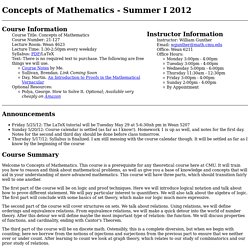
Homework 1 is up as well, and notes for the first day. Notes for the second and third day should be done before class tomorrow.Thursday 5/17/12: Syllabus is finalized. I am still messing with the course calendar though. It will be settled as far as I know by the beginning of the course Course Summary. Proofs from The Book - The most elegant axioms, theorems, and proofs in school mathematics. Math 3005 - A Transition to Higher Mathematics. TextbookThe 2nd edition of Mathematical Proofs: A Transition to Advanced Mathematics by Gary Chartrand, Albert D.

Polimeni, and Ping Zhang. Solutions to Selected Homework ProblemsBelow you will find links to the solutions of some of the homework exercises that have been assigned. Please note that the solutions given are not the only possible solutions, but are intended to represent acceptable proofs that would receive full credit. If you notice an error of any sort, please let me know so that I can correct the mistake. Chapter 3: Direct Proof and Proof by Contrapositive. Math Foundations C (150.
Fundamentals of mathematics. Catalog Record: Fundamentals of mathematics | Hathi Trust Digital Library Navigation HathiTrust Digital Library Search this index Main Content Similar Items.

Fundamentals of mathematics. Fundamentals of practical mathematics. Modern mathematics, briefer course : a... A brief introduction to the infinitesimal... An essay on mathematical language; or, An... Catalog Record: An essay on mathematical language; or, An introduction to the mathematical sciences | Hathi Trust Digital Library Navigation HathiTrust Digital Library.
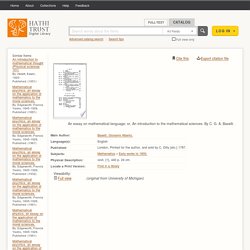
Introduction to mathematical logic and its... An introduction to probability and... An introduction to probability and... Introduction to mathematical statistics. The axioms of descriptive geometry. New elements of mathematics: or Euclid... Elements of mathematics : containing... The analyst: or, An introduction to the... A new and easy introduction to the... Catalog Record: A new and easy introduction to the mathematics; containing, I.
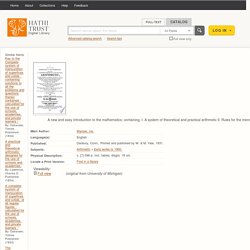
A system of theoretical and practical arithmetic II. Rules for the mensuration of superfices and solids III. Rules for solving a number of useful and interesting mathematical, philosophical, and chronological problems. IV. Elements of mathematics : containing... Natural geometry: an introduction to the... New elements of mathematics: or Euclid... The axioms of descriptive geometry. The rudiments of mathematics : designed for... An introduction to algebra, being the first... Introduction to algebra, being the first part... First book of mathematics, being an easy and...
Introduction to mathematics [by] Charles F.... An introduction to algebra, being the first... Mathematics 108, Introduction to differential... Catalog Record: Mathematics 108, Introduction to differential calculus | Hathi Trust Digital Library Navigation HathiTrust Digital Library Search this index Main Content Similar Items Tools.

Introduction to college mathematics. Modern mathematics, an introduction. Catalog Record: Modern mathematics, an introduction | Hathi Trust Digital Library Navigation HathiTrust Digital Library Search this index Main Content Similar Items. Fundamentals of mathematics. An introduction to modern mathematics. Catalog Record: An introduction to modern mathematics | Hathi Trust Digital Library Navigation HathiTrust Digital Library Search this index Main Content Similar Items.